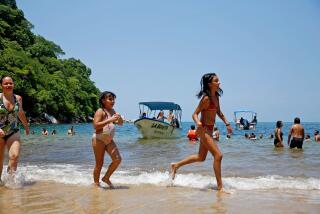Caution still urged for visitors to Nepal
- Share via
AN estimated 12,500 people were killed during the decade-long Maoist insurgency in Nepal. Bombs exploded in busy tourist areas, demonstrations erupted in violence and road blockades disrupted transportation, but no tourists were killed.
The most serious threat occurred in the mountains, where Maoist bands stopped trekkers and demanded money. Those who resisted were threatened or detained.
In 2002, Maoists stopped American travel writer Jeff Greenwald in the middle of a trek. “My entire group was forced to pay $100 each in order to continue onward,” Greenwald said. “We were given printed receipts for our ‘contributions’ and were told to show these as proof of payment to any other Maoists we might encounter.”
As a result of such incidents, the U.S. State Department issued a warning about travel to Nepal. The warning was updated Dec. 8, soon after the signing of a peace accord between the Nepalese government and the Maoists. Among other things, the parties agreed to allow free movement throughout the country for locals and tourists.
The Nepal Tourism Board hailed the accord and issued a statement welcoming back visitors. But in its warning, the U.S. State Department, although noting positive developments, cites human rights abuses and cautions Americans about trekking and travel by road outside Katmandu.
“The responsibility for determining whether to travel to Nepal lies exclusively with the individual traveler,” said Catherine Barry, the deputy assistant secretary of State for Overseas Citizens Services. “That being said, the security situation in Nepal vis-a-vis the Maoists certainly requires special consideration on the part of the traveler.”
During the height of the insurgency, Maoists issued anti-U.S. statements that raised concerns that Americans were being targeted. But the former Nepalese minister for culture, tourism and civil aviation disputed that. “I do not think American tourists were ever targeted during the last 10 years of trouble,” Yankila Sherpa said in an e-mail.
During my trip in November, I never felt threatened or insecure. The only evidence of the turmoil I saw were police stations in Pokhara, south of the Annapurnas, encased in barbed wire and surrounded by sandbags. My Nepalese guide laughed when he saw them. “The police are very afraid of the Maoists,” he said.
More to Read
Sign up for The Wild
We’ll help you find the best places to hike, bike and run, as well as the perfect silent spots for meditation and yoga.
You may occasionally receive promotional content from the Los Angeles Times.






